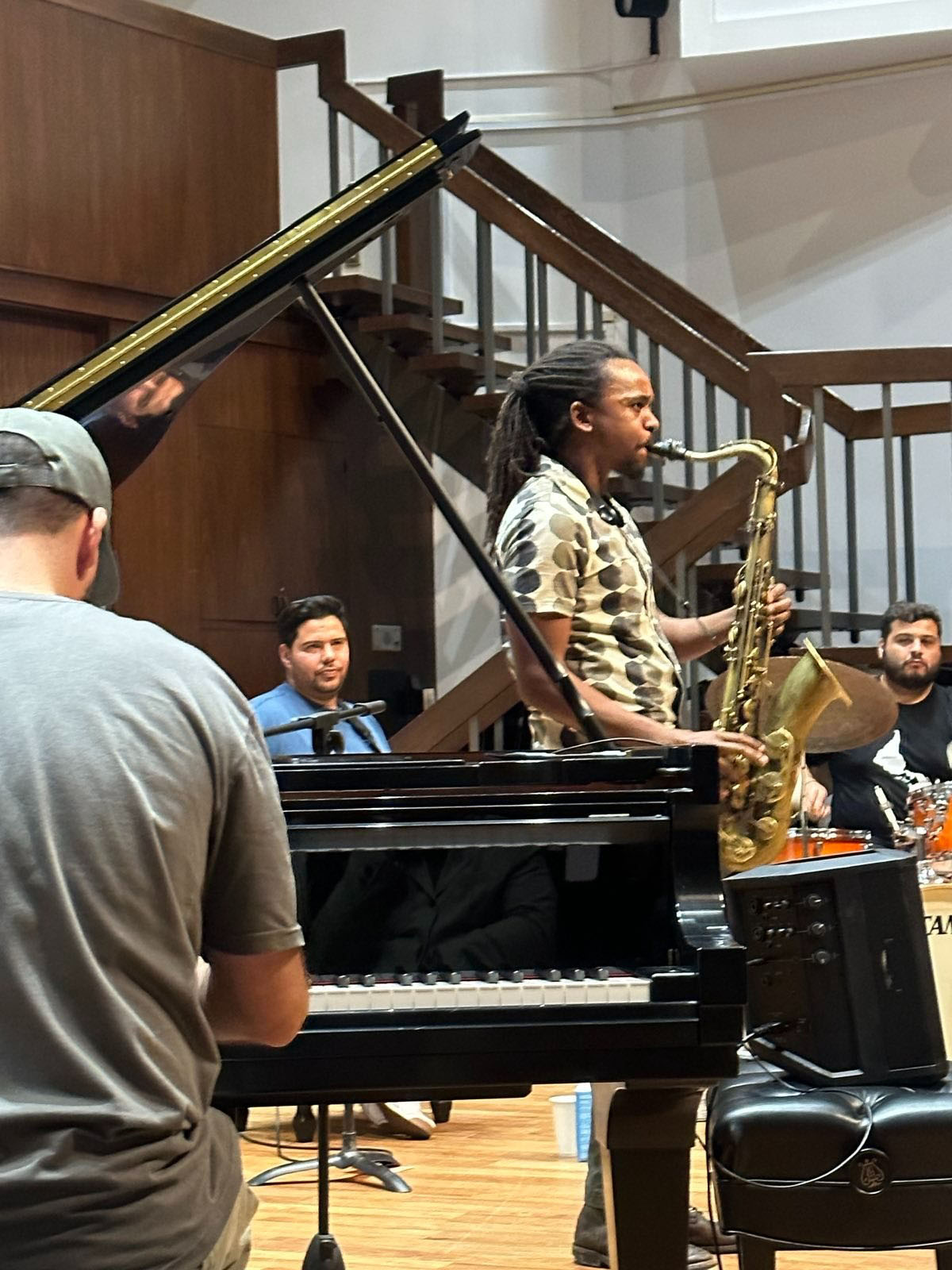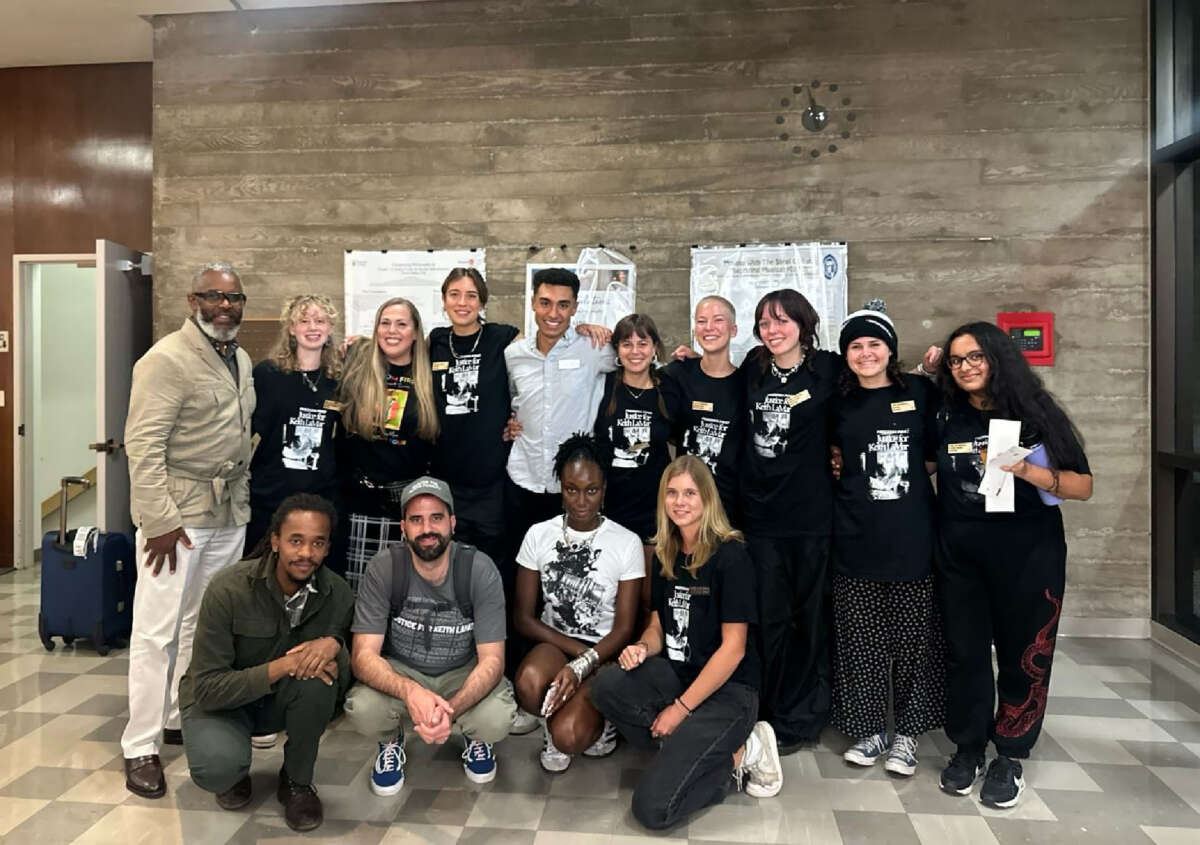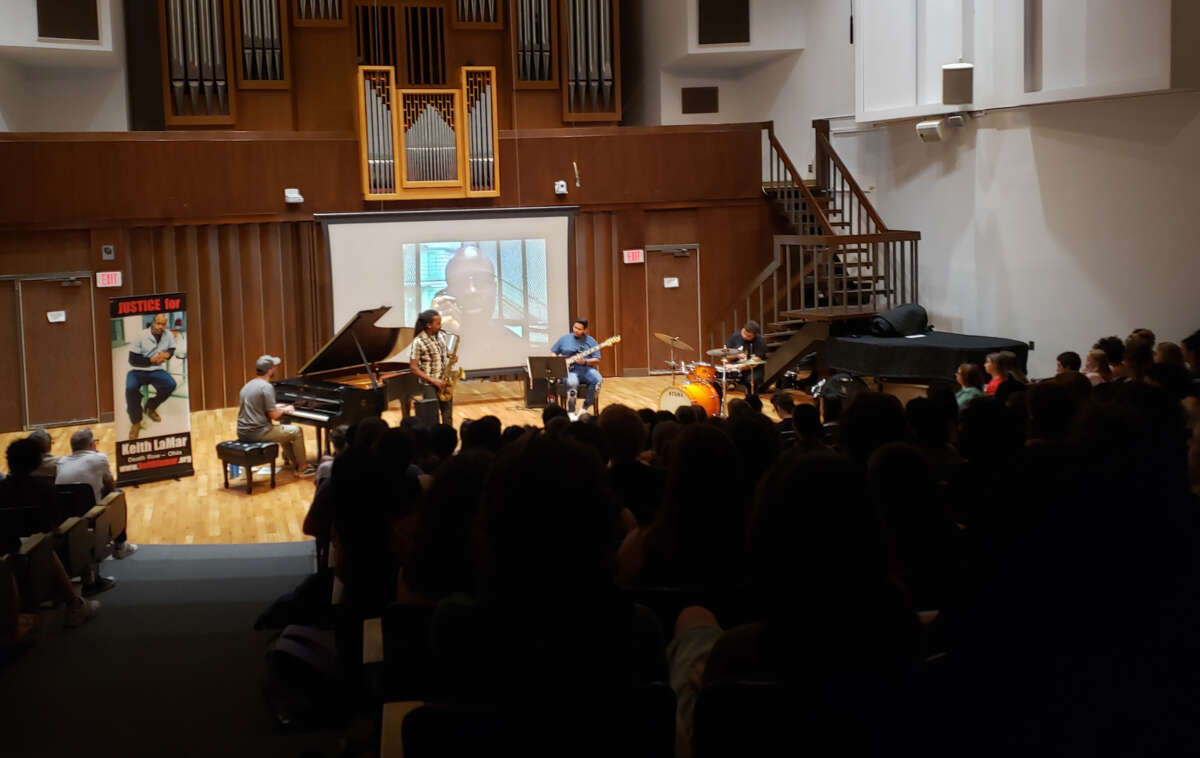This fall at a concert hall in Claremont, California, a sold-out crowd of some 240 people got a call from death row.
“I can hear you,” said a man the state of Ohio intends to execute on January 13, 2027. His execution date was previously set for today, November 16, until a reprieve issued in July by Gov. Mike DeWine postponed it.
On the campus of Pomona College, a private school where privilege and affluence are synonymous with student life, those gathered inside Lyman Hall at the October 7 concert erupted in applause.
“Hello everybody,” the voice calling from Ohio State Penitentiary said, as music started playing. “My name is Keith LaMar.”
The performance that night was part of a concert series that visited Southern California thanks in part to months’ worth of work by the 5C Prison Abolition Collective student organization.
“Keith LaMar is a wrongfully accused death row prisoner,” Leila Riker, a member of the collective said at the start of the event. “In other words, Keith LaMar is an innocent man being held in a cage while he waits for the day the state will take his life. I want the gravity of that to [set] in.”
Riker said she first learned about LaMar because he had helped get a club going at her high school in New York City.
“The fact that someone [who] was locked up on death row, someone who was being denied all opportunities to interact with the world, had somehow broken through and was teaching made me start to think critically about prisons for the first time,” she said. “All of Keith’s work is an attempt to connect with the world, to make a lasting impact and to fight for his freedom.”
Together with the 5C Prison Abolition Collective, the Pomona Student Union co-hosted the event that night.
LaMar was sentenced to prison decades ago after he killed another young man who was trying to rob him. That happened in 1989, when LaMar was 19 and selling drugs in Cleveland to survive. In 1993, he was inside the Southern Ohio Correctional Center when people incarcerated there took control of the facility and held guards, as well as other prisoners, hostage. Later, after what came to be known as the Lucasville Uprising, LaMar was offered a plea deal contingent upon admitting that he killed fellow prisoners during the revolt. Refusing to confess to murder he maintains he did not commit, LaMar went to trial, was convicted by an all-white jury and sentenced to death.
LaMar’s campaign suggests the prosecution withheld evidence that might have exonerated him, in violation of his Brady Rights.
Although many people throughout the United States and beyond have come to learn about LaMar, who has now been in solitary confinement for about three decades, few know the history behind his struggle. Fewer still know the details of how his life took a pivotal turn when, fortified by an outpouring of love and support, he took control of his own narrative and, from the confines of a small cell, ignited a growing movement full of people who have come to embrace the adage he’s fond of repeating: “Love is the only freedom.”
“There Is This Urge Toward Freedom”
As musicians on stage played jazz, LaMar, whose voice over the phone was amplified through speakers, recited poetry, much of which can be found on the Freedom First album he recorded with acclaimed pianist and composer Albert Marquès, who performed that night in Lyman Hall.

As Marquès explained during the early October concert, it was early on in the COVID-19 pandemic when the idea for the Freedom First concert series first took root.
“I was going to the [Black Lives Matter] protests in New York City, and I was also playing on the streets a lot in the neighborhood where I live, Flatbush; we were playing outdoors, and that’s where I made that connection,” he told the crowd in Claremont.
Salim Washington, another jazz musician and composer Marquès worked with, got to know LaMar and played tenor sax on the song “Alabama” featured on Freedom First.
“The thing is that when you play with like-minded people, something can happen that is difficult to put your finger on,” Washington explained in relation to the music that’s become a key part of LaMar’s campaign.
You can put great musicians together and get competent or even good music, he said, but for the art to become transcendent requires the artists to be focused and open.
“And in this project, there is this openness,” he said. “There is this sincerity, and there is this urge toward freedom, which for me is what the music is about at its best.”
In addition to putting out the album, musicians involved in the Freedom First concert series have visited Manhattan, San Francisco, Cleveland, Akron, East Lansing, Santiago de Chile, Barcelona and Madrid, to name just some of the stops so far.
A Turning Point
The concerts and the current iteration of the campaign, featured in The New York Times in early 2022, might not have materialized if not for LaMar making the decision to go on hunger strike in early 2011.
Around that time, late labor historian and attorney Staughton Lynd, who wrote a book about the Lucasville revolt and who became close with LaMar, shared with his incarcerated friend a book by sociology professor Denis O’Hearn, Nothing But an Unfinished Song: Bobby Sands, the Irish Hunger Striker Who Ignited a Generation, which provided impetus and inspiration to launch his own strike with fellow prisoners.
“That was like a turning point,” LaMar said, “because that really happened right after I had [gone] back for my evidentiary hearing and discovered that the court wasn’t going to grant me the release I was after. I felt — and the system is designed to deliver you to this conclusion — I felt like I had [run] out of options, that I had come to the end of the road and that there was nothing left to do but accept what I took [as], or what I was given to believe was, a fate. And then one day, lo and behold, this book arrived, Nothing But an Unfinished Song; I read it, and it resonated.”
Reading about the Irish Republican Army (IRA) member who ultimately died during a hunger strike helped LaMar regain his “sense of agency,” he explained in writing, also noting: “It was the most important book I’ve ever read; it saved my life.”
Though he and Sands came from different backgrounds, he noticed similar patterns in the IRA freedom fighter’s development, and he felt in some ways as though he was reading about his own life. “As I [pored] over the pages,” LaMar explained in written work, “I caught an abiding sense that I was being sent a message. In years past, whenever I found myself plagued by doubt and confusion, something (or someone) would show up to point the way forward — and most times these messages came in the form of books.”
Rather than “mere coincidences,” those incidents for him came to represent answers to questions — like what he could do to hug his family again — that he put out into the universe.
Soon after reading Nothing But an Unfinished Song, LaMar wrote a letter to O’Hearn. They started corresponding and another friendship blossomed.
During the parts of the year he was teaching at State University of New York Binghamton, O’Hearn said he would make the approximately six-hour drive to Youngstown, Ohio, to visit LaMar, who also goes by Bomani Shakur.
O’Hearn’s work on Sands is what inspired LaMar’s life-altering action. He and two other prisoners on death row made the decision to risk their health and put their bodies on the line. LaMar had gone almost two decades without being able to touch his family, but after the strike, the prison allowed contact visits.
With the camaraderie of two other prisoners, he achieved in a dozen days what he hadn’t been able to do in years, and that prompted a paradigm shift.
“This made me believe that I needed to be a prominent voice in my own life, my own struggle, and that’s something that I continue to insist on, even to this day,” he said. “Of course, you can’t do anything by yourself. So you need the help of other people, of course.”
O’Hearn quickly became one of those people.
“Within a week after the end of that hunger strike, we went in and met with Bomani and broke bread with him, shared food, kissed, hugged — you know, through a little window, but still it was a semi-contact visit, and eventually they became full-contact visits,” O’Hearn told Truthout.
Cultivating Outside Support From the Inside
Throughout all this, LaMar had come to identify with Sands and the IRA comrades he read about.
“But the thing that I didn’t have that Bobby had was outside support,” he told Truthout. “So I started to cultivate outside support.”
In late January 2011, LaMar penned an open letter for the San Francisco Bay View that acknowledged and built on the love and support that would continue to grow as his words touched and moved more and more people.
Mary Ratcliff, who along with her husband has published the Bay View since 1991, told Truthout that he’s one of the best writers she’s encountered.
“His writing is beautiful,” Ratcliff said. “He has a beautiful command of the English language. And so it’s a joy to read, even when he’s talking about things that are so ugly. He doesn’t lay blame. He explains what he believes people’s motives were and treats everybody with dignity — everybody, including the people who were persecuting him most.”
In his 2011 article for her outlet, LaMar underscored an enduring theme in his campaign for justice, affirming “a great feeling of love — for you, the people,” which, as he explained, provided him guidance.
“When one has been forced to live in a space no larger than a closet for 16 years, 23 hours a day, not only does one begin to feel extremely insignificant, but the very world begins to shrink; and everything, even the smallest thing, seems impossible,” he wrote in the letter that’s also included in Condemned, a book he authored and self-published in 2014. “Hence, never in my wildest dreams could I have imagined the overwhelming outpouring of love and support that came flooding into my cell after I cried out for help.”
Amy Gordiejew, who would become one of LaMar’s closest friends, connected with LaMar after learning about him through Staughton Lynd and his wife Alice in 2010. She started visiting him several months later, and she helped LaMar bring Condemned to publication. LaMar read a lot of what became the book to her over the phone for Gordiejew to transcribe because pages of the manuscript he tried mailing never got delivered. Despite the painstaking process, they finished the project, and LaMar took control of his own narrative with help from a close friend.
“It’s really been the connective tissue to a whole lot of other things,” Gordiejew told Truthout. “It’s what allowed people to know him and his story. It’s what has allowed a lot of things to kind of fall in place.”
Mother Jones reached out during the pandemic, and LaMar wrote a piece the outlet published in March 2020 about how to make the best use of time alone. Gordiejew attributes the news outlet’s interest to LaMar telling his own version of events.
Putting his narrative and uncensored insights out there, replete with penetrating analysis and poetic prose that reflects the influence of authors like Khalil Gibran and Richard Wright, whose work he’s studied, made it so LaMar wasn’t rehashing the same facts over and over again.
Gordiejew said this afforded him the chance to share with people more of what he was thinking, and the lessons he learned.
LaMar shares some of that on the second season of “The Real Killer,” a podcast hosted by Leah Rothman. A journalist by trade, Rothman had an interest in the Lucasville uprising, and decided to do a deep dive to explore one of the longest prison uprisings in history along with the people impacted by it. She spent 11 months working on what became an 11-episode season, which Rothman said should have been 50 episodes, minimum, following what really warranted years’ worth of investigation.
Rothman established good rapport with LaMar over the phone prior to interviewing him in person. Still, she was “super nervous” before talking to him inside the supermax facility.
“But it was kind of like spending time with a friend — a new friend, but also a friend that I had, like, sort of a deeper connection to,” she told Truthout. “He’s very warm. Keith is very welcoming. I think I just got a very good sense from him in person. Very quickly we were laughing about stuff. It was like talking to somebody that I had known for some time.”
One of LaMar’s greatest strengths, she surmised, is that he acts as his own best advocate.
“I think that he does a very good job of explaining his position and why he is where he is, and I think that acts like a magnet almost,” she said. “I think it attracts people to him and his story.”
LaMar has likely affected more lives than he probably knows, according to another one of his friends and supporters, Jason Fulford, an organizer who started “Run for Justice” events to keep the injustice of unaccountable police violence in the public consciousness and to honor his cousin Eric Garner, who was murdered by police in 2014.
Fulford first learned about the 54-year-old on death row when a friend of his who was wearing a “Justice for Keith LaMar” shirt asked to speak at the first “Run for Justice” held in the Brooklyn neighborhood where Fulford used to live.
“I didn’t even know about Keith Lamar at that time,” Fulford said, “but something in me kind of made me pass him the mic.”
Fulford got a message from LaMar the next day. Then he helped with a Freedom First jazz concert in Brooklyn. When LaMar’s crew visited Northwestern University in Evanston, Illinois, he organized a run/walk event that took place nearby, in downtown Chicago, the day after the concert. He also helped LaMar tell his story in audio format and he continues to support his friend’s campaign for freedom.
“The biggest thing is the police officers in 2014 took my cousin’s last breath,” Fulford said, “and I feel like I’m obligated to stand with somebody that’s still breathing, so that the system doesn’t take his last breath.”
Pushback From Prison Authority
His resolve probably doesn’t hurt either.
“I’ve had to go on additional hunger strikes since the initial hunger strike of 2011 almost every year — or [under] every warden, definitely,” LaMar said in March, soon after having concluded another strike, which he started back in February 2023 after experiencing an uptick in guards harassing him in the visiting room.
After the warden gave him her word she would look into the harassment, he suspended the strike, which proved successful in addressing his immediate concerns. He dealt with the problem of officers interfering with his access to art supplies a few months later, however, and he expects that sort of thing to continue while he remains incarcerated.
“If you intend to push back against the forces that are trying to oppress you, the forces that are trying to test you, then you’re gonna have to deal with a lot of push back,” he said.
The likelihood of repercussions aside, LaMar has no qualms about letting people know he believes in what he’s doing.
“It’s not an act,” he said. “This is not like a ploy. This is my life.”

From Thinking Outside the Box to Living Outside the Box
Before the students inside Lyman Hall stood to give a standing ovation, they got the chance to make music with LaMar and the artists on stage.
The musicians played the song “Acknowledgement,” which is also featured on the Freedom First album. With the song, LaMar pays homage to the jazz saxophonist John Coltrane, whose music he credits with teaching him how to improvise in his quest for freedom and justice. That evening in early October, the concert more or less concluded with LaMar rhythmically repeating, “A Love Supreme,” like Coltrane did on the first track of his 1965 record of the same name. The crowd joined in unison.
Following a short break after the performance ended, LaMar, still on the phone, fielded questions from students who stuck around.
One asked how they could best support his cause and the movement for prison abolition.
In response, LaMar said you realize what’s possible when you act in ways that make you aware of what you’re made of. He encouraged students to analyze macro-level issues and to interrogate the societal values that perpetuate injustice.
“You’ve got to think outside the box,” LaMar said, “and once you start thinking outside the box you start living outside the box.”
